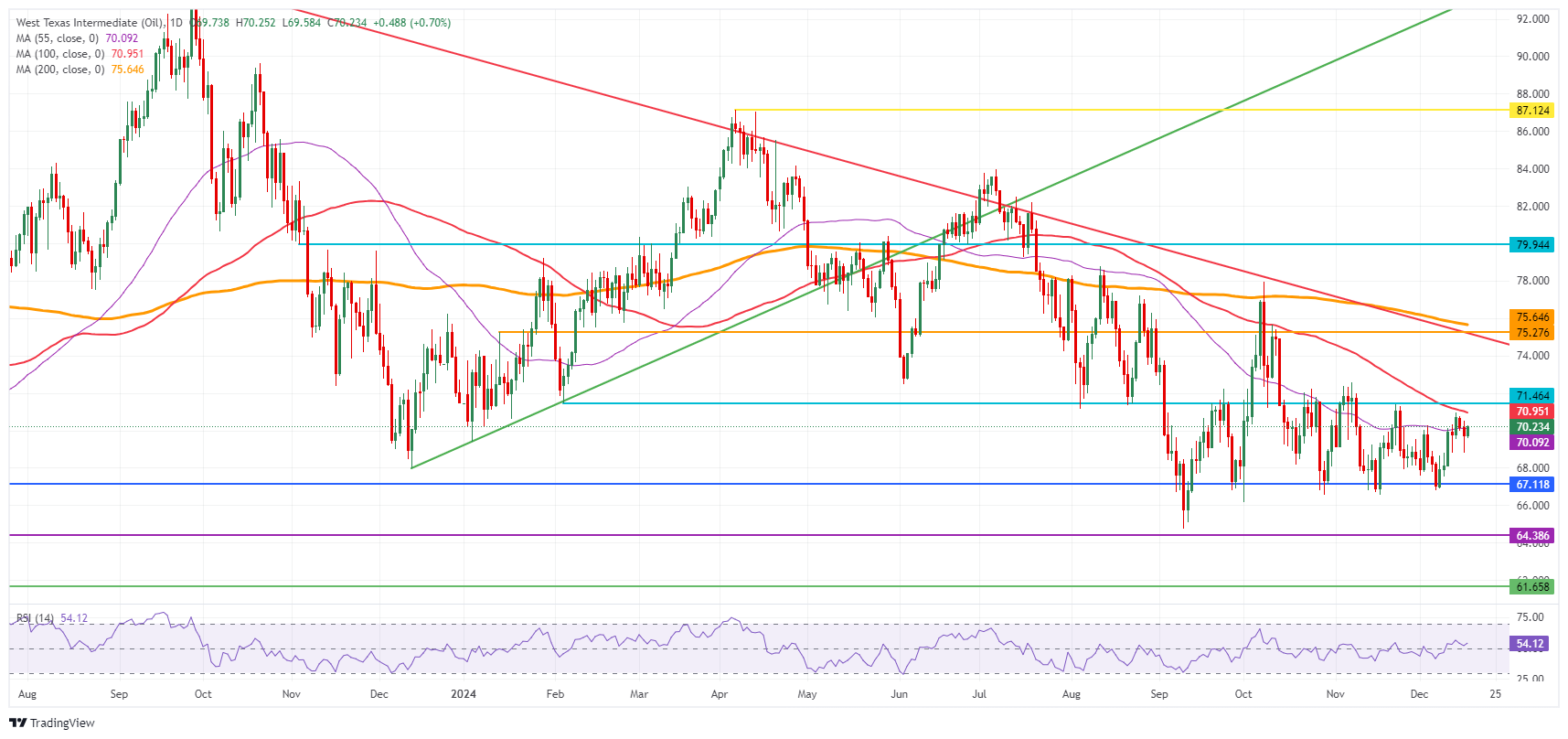- Oil prices are trading back around $70.00 after an unexpected decline in US API data.
- Kazakhstan is set to increase oil production next year, according to Bloomberg.
- The US Dollar Index is trading around 107.00 ahead of the last Fed meeting of 2024.
Crude oil is trading slightly higher on Wednesday around the $70 round level amid recent headlines providing both headwinds and tailwinds. Some support for crude oil prices came after a sizeable reduction in the American Petroleum Institute’s (API) crude stockpile change figures on Tuesday. With a decline of 4.7 million barrels, larger than the expected decline of 1.85 million barrels, crude oil prices received a small boost.
However, some bearish news for oil comes from Kazakhstan. Prime Minister Olzhas Bektenov said on Tuesday he had ordered the Energy Ministry to step up efforts to increase natural gas and oil production. The Energy Ministry must ensure that 2025 oil production is at the planned level, Bektenov said, Bloomberg reports.
The US Dollar Index (DXY) – which measures the performance of the US Dollar (USD) against a basket of currencies – is fairly flat ahead of the last Federal Reserve (Fed) meeting of 2024. A rate cut is expected of 25 basis points, lowering the reference rate from 4.75% to 4.50%. The focus will rather be on the dot plot projections, which will show whether Fed officials are considering a Trump effect with stable or higher rates in the coming years.
At the time of writing, Crude Oil (WTI) is trading at $70.14 and Brent Crude at $73.42.
News on Oil and markets: Kazakhstan challenges OPEC
- Oil production plans in Kazakhstan’s budget indicate an increase of 9.4 million metric tons next year, or about 190,000 barrels per day. That’s more than double the current 41,000 barrels Kazakhstan is producing under the OPEC+ production cap deal, Bloomberg reports.
- The Energy Information Administration (EIA) will publish weekly crude oil reserve change figures around 15:30 GMT. A reduction of 1.7 million barrels is expected compared to last week’s decrease of 1.425 million barrels.
- The price of key Middle East grades is rising, according to traders who deal in the region’s typically higher-sulphur, or sour, oil. Qatar’s Al-Shaheen cargoes for loading in February were about $1 per barrel more expensive than the regional benchmark, compared with a premium of up to 70 cents for January, Bloomberg reports.
Technical Analysis of the oil price: Without breaking any plates
Crude oil prices seem unable to move away from $70.00 in either direction as, for almost six consecutive trading days, crude oil prices have been pushed back to that level. With liquidity starting to decline, it looks increasingly likely that this will be the stable level for the final trading days of 2024.
Looking up, $71.46 and the 100-day SMA at $71.03 are acting as firm resistance levels. On Friday, some selling pressure already emerged ahead of that same 100-day SMA. In case oil traders can break through that level, $75.27 is the next crucial level, although be wary of quick profit taking with the end of the year fast approaching.
On the downside, it is too early to see if the 55-day SMA will be reclaimed at $70.12. That means that $67.12 – a level the price held in May and June 2023 – remains the first solid support nearby. Should that be broken, the 2024 year-to-date low emerges at $64.75 followed by $64.38, the 2023 low.
WTI Crude Oil Daily Chart
WTI Oil FAQs
WTI oil is a type of crude oil that is sold in international markets. WTI stands for West Texas Intermediate, one of the three main types that include Brent and Dubai crude. WTI is also known as “light” and “sweet” for its relatively low gravity and sulfur content, respectively. It is considered a high-quality oil that is easily refined. It is sourced in the United States and distributed through the Cushing facility, considered “the pipeline junction of the world.” It is a benchmark for the oil market and the price of WTI is frequently quoted in the media.
Like all assets, supply and demand are the main factors that determine the price of WTI oil. As such, global growth can be a driver of increased demand and vice versa in the case of weak global growth. Political instability, wars and sanctions can alter supply and impact prices. The decisions of OPEC, a group of large oil-producing countries, is another key price factor. The value of the US Dollar influences the price of WTI crude oil, as oil is primarily traded in US dollars, so a weaker Dollar can make oil more affordable and vice versa.
Weekly oil inventory reports published by the American Petroleum Institute (API) and the Energy Information Agency (EIA) influence the price of WTI oil. Changes in inventories reflect the fluctuation of supply and demand. If the data shows a decline in inventories, it may indicate an increase in demand, which would drive up the price of oil. An increase in inventories can reflect an increase in supply, which drives down prices. The API report is published every Tuesday and the EIA report the next day. Their results are usually similar, with a difference of 1% between them 75% of the time. EIA data is considered more reliable since it is a government agency.
OPEC (Organization of the Petroleum Exporting Countries) is a group of 13 oil-producing nations that collectively decide member countries’ production quotas at biannual meetings. Their decisions often influence WTI oil prices. When OPEC decides to reduce quotas, it can restrict supply and drive up oil prices. When OPEC increases production, the opposite effect occurs. OPEC+ is an expanded group that includes ten other non-OPEC member countries, including Russia.
Source: Fx Street
I am Joshua Winder, a senior-level journalist and editor at World Stock Market. I specialize in covering news related to the stock market and economic trends. With more than 8 years of experience in this field, I have become an expert in financial reporting.








